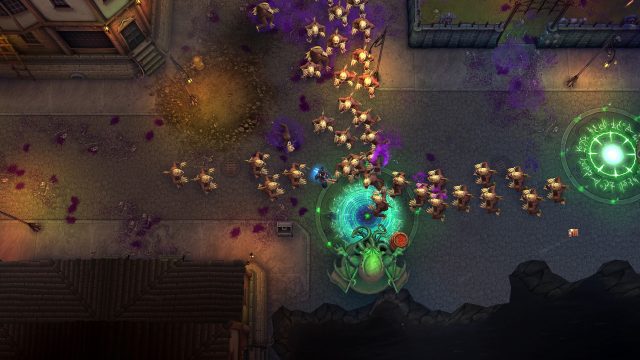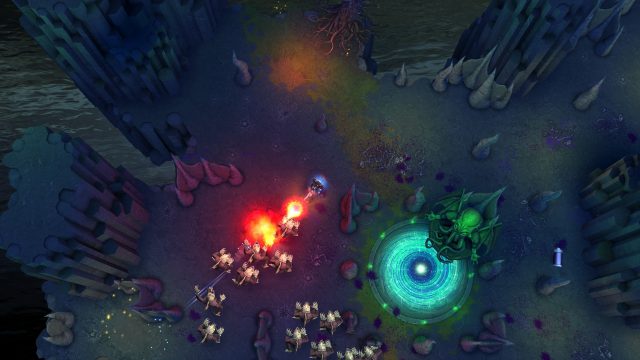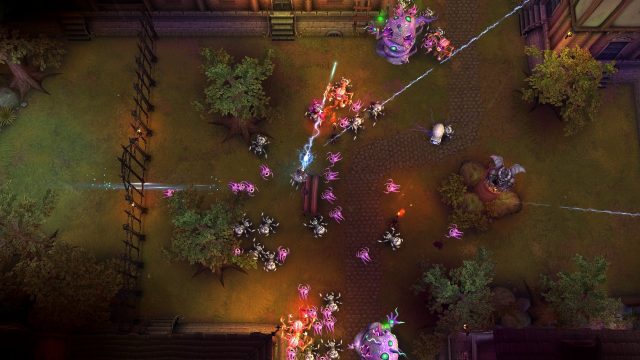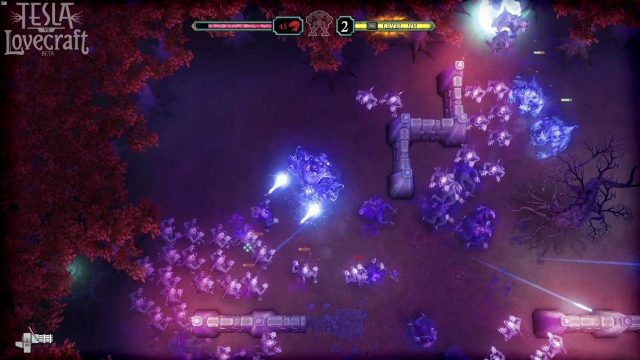
Twin stick shooters haven’t been as prevalent as they once were, but that hasn’t stopped 10 Tons from doing what it does best. Nor has it prevented them from being creative and taking advantage of the freedom that making indie games allows. The result is a brand new and rather quirky joystick shooter that pits two of history’s most interesting people against each other. They call it Tesla Versus Lovecraft.
Set within the last hundred or so years, Tesla Versus Lovecraft is a game that is heavy on bullets and gore, but light on story. There are a couple of cutscenes, those being the opening and closing scenes, but other than that it’s rather devoid of dialogue or anything like it. Then again, this genre isn’t exactly known for great storytelling, nor does it need rich narratives. The developers deserve credit for what they have done, and that’s setting Lovecraft after Tesla by way of anger and worry.
Things begin in a theatre, where Nikola Tesla is preparing to show off his latest, electricity-fueled creation. He doesn’t get very far, though, because it isn’t long before the famed horror writer storms the stage and asks for things to cease. Tesla won’t, and thus begins a heated, hateful and downright deadly rivalry between the two.
Simply put, Lovecraft sends his minions after Tesla, and the latter is forced to survive many increasingly difficult stages of combat against them as his invention is prepared for use. Stages that are made up of things like gothic towns, dark cemeteries and a dangerous mountain.

The aforementioned story is the interesting backdrop that propels this quirky mix of electricity, inventions and demonic creatures. As Tesla, players use a top down view to move around a surprising amount of stages, as they do battle against all kinds of creatures. First comes a demonic mixture of dogs and fish, then spiders, and after that all hell breaks loose with varying sizes of grotesque abominations, including fire vampires.
Each of Tesla Versus Lovecraft‘s stages end up being a few minutes long at most, but lots is packed into each one. If you’re not teleporting out of danger, then unleashing bullets on massive amounts of incoming enemies, you’re trying to destroy the portals that bring them to life. This is done with a nice amount of weaponry that includes a revolver, a tommygun, a death ray and two types of shotguns, among others.
Since a twin stick shooter without special abilities isn’t as fun as one with them, 10 Tons has included lots of different powers and perks. You earn such perks as you level up within each stage, and that’s accomplished by simply killing as many enemies as you possibly can. Perks can build upon each other, and come in many varieties. At first, you’ll only be offered the basics, like ‘More Health,’ ‘Sharper Bullets’ (which cause more damage) and ‘Faster Movement,’ but after a while they’ll start to get more complex. By the end of the game, you’ll be able to select rubber bullets that bounce around the screen, a poison buffer that poisons enemies who come close, an electrical discharge and Tesla’s aforementioned death ray.

Other special powers also appear throughout the maps, including health packs, fire bullets, shields, balls of energy and sparks that momentarily freeze enemies. These can help turn the tide of battle, but not to the extent of the perk system.
The best part of this game, however, happens to be the mech suit. It doesn’t appear until you’re a few missions in, but eventually becomes the way in which one begins each stage. It only has a limited amount of use and armour, though, meaning that it breaks quickly and is merely a brief power-up, for lack of a better term. Once it becomes available, you’ll find yourself hunting its marked pieces within each stage, so as to be able to use its powerful miniguns whenever you feel the need. It’s not a one time use type of thing, either; so long as you continue to pick up its several different parts.
The gameplay is quite easy at first, but eventually becomes very hectic and allows for upwards of one hundred enemies to be on screen at one time. This makes later stages an exercise in survival and avoidance, as you attempt to run and teleport your way out of danger while shooting. Teleportation is limited, though, which is why it can’t be spammed or abused.
Even on its first difficulty (which is forced upon the player, through a design that wants you to go through the campaign three times across different ‘planes’ or difficulties), Tesla Versus Lovecraft isn’t an easy game. It’s not cheap or unfair, but it does have a good challenge to it that is further heightened within the other two planes. It also allows for co-op, which is a helpful option for anyone who wishes to play with a friend.

For the most part, all of the above works quite well. The action is fast and frenetic, and can even become quite frantic. There’s also a good amount of difficulty that should please even hardcore twin stick shooter fans. There are issues, though, such as a health meter that can sometimes be difficult to see, missions that don’t necessarily tell you what you’re supposed to do, and repetition from repeated maps and mechanics. If you don’t pay attention to your surroundings, certain levels will continue to spawn enemies until you look around and find portals that can be destroyed. Other times, your only job is to kill every enemy in sight, but the game doesn’t ever tell you which is which.
Boss battles conclude each of the three chapters, and they’re a bit on the basic side. You survive for a certain amount of time (say eighty to one hundred seconds), and at that point the boss will spawn. Then, all you have to do is move around and pump lead into it, which is made a lot easier by the mech suit.
I played this game on our Xbox One X review unit, and had almost nothing in the way of issues. There was maybe one instance where the frame rate slightly slowed, but even then I’m grasping. Despite having so many different creatures on screen at once, Tesla Versus Lovecraft both looks good and runs well, with a colourful art style that pumps out neon-like hues of blue, green and purple.
The sound isn’t nearly as impressive, but it does the job. This is the type of game where you can expect to hear the same mediocre original tunes over and over again, and at a loud volume. That, as well as lots of shots, explosions and burst enemies. There is a bit of voice acting, as well, but it’s nothing to write home about and honestly doesn’t need to be.
Tesla Versus Lovecraft came out of nowhere, but it doesn’t deserve to fade away and become forgotten. This is a pretty fun, frenetic and somewhat quirky twin stick shooter that should please all who’ve ever enjoyed the genre.
**This review is based on the Xbox One version of the game, which we were provided with.**

